#American Reservation
Text
He’s so shy 🥹, he didn’t seem to amused, when he was walking in a fan ran up to him which was not nice :/
🎥:jherbo10
#so reserved 🥹#I appreciate he took time out of his day to do something he’s not a big fan of ❤️#love him#joe burrow#cincinnati bengals#bengals#nfl#football#nfl football#american football
140 notes
·
View notes
Text
A really good thread on Killers of the Flower Moon by Indigenous Canadian actress Devery Jacobs (Reservation Dogs):






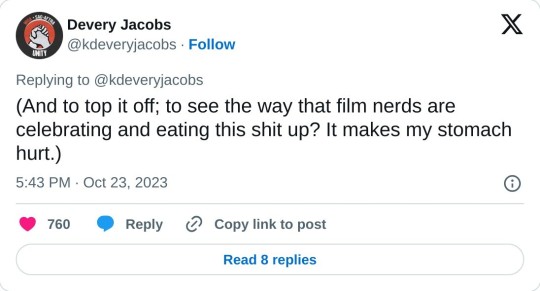


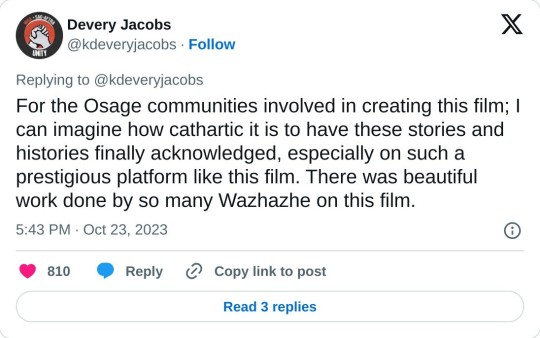


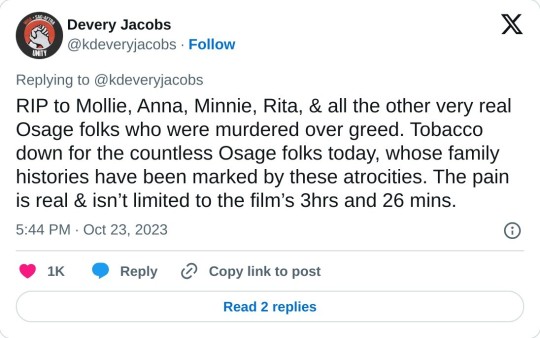

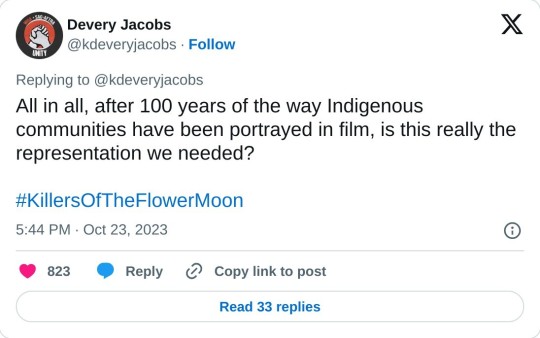
#reservation dogs#devery jacobs#native american#killers of the flower moon#films#anti native racism#martin scorsese
389 notes
·
View notes
Text
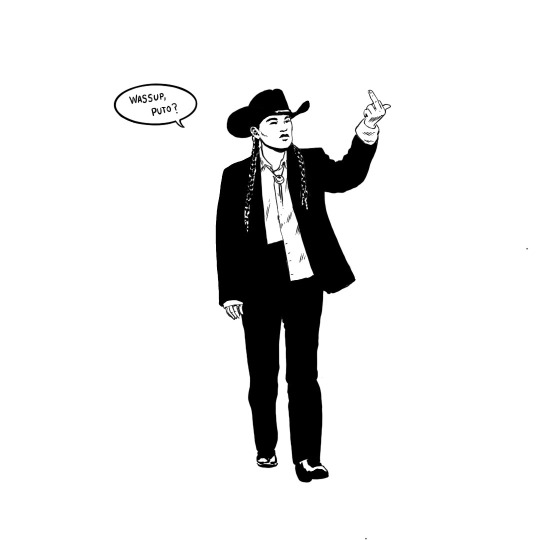
The great and powerful Willie Jack
If you’re not watching Reservation Dogs, then fix that immediately.
#reservation dogs#rez dogs#res dogs#art#drawing#illustration#inking#ink#fan art#paulina alexis#willie jack#wassup#tv shows#black and white#native women#native art#native american#native love#native pride#badass ladies#badass lady
391 notes
·
View notes
Text

Reservation Dogs 3.03 "Deer Lady"
This episode was a real gut punch.
#reservation dogs#rez dogs#boarding school#deer lady#indigenous lives matter#mmiw#native american#indigenous representation#missing and murdered indigenous women#indigenous history#taika waititi#sterlin harjo#d'pharaoh woon a tai#bear smallhill#native american boarding schools#native boarding school#indigenous boarding school#american indian boarding schools
183 notes
·
View notes
Text
I FULLY AND WHOLEHEARTEDLY RECOMMEND THIS SHOW ON HULU AND FX
Reservation Dogs
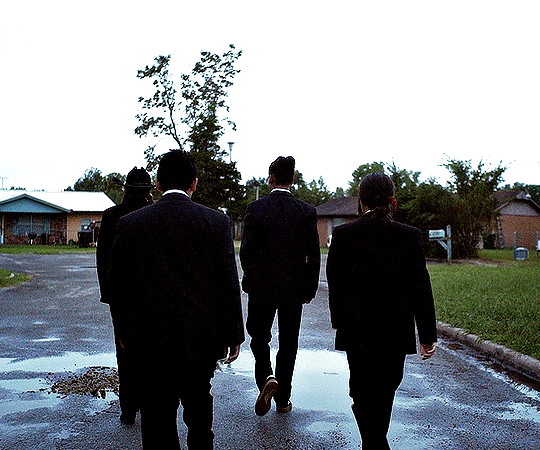
If you’re looking for a new show to binge, please do. this show deserves all the attention and glory.

#Emmy snubs#emmys#drama#comedy#indigenous#indian reservation#native american#native people#native#black panther#Talokan#hulu originals#hulu streaming#hulu#reservation dogs#reservation#indigenous land#cultural masterpiece#1000/10
165 notes
·
View notes
Text
Why the Fed wants to crush workers
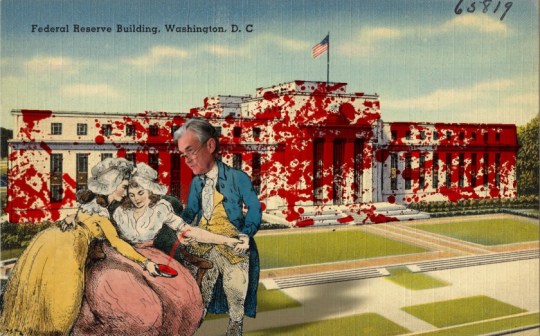
The US Federal Reserve has two imperatives: keeping employment high and inflation low. But when these come into conflict — when unemployment falls to near-zero — the Fed forgets all about full employment and cranks up interest rates to “cool the economy” (that is, “to destroy jobs and increase unemployment”).
An economy “cools down” when workers have less money, which means that the prices offered for goods and services go down, as fewer workers have less money to spend. As with every macroeconomic policy, raising interest rates has “distributional effects,” which is economist-speak for “winners and losers.”
Predicting who wins and who loses when interest rates go up requires that we understand the economic relations between different kinds of rich people, as well as relations between rich people and working people. Writing today for The American Prospect’s superb Great Inflation Myths series, Gerald Epstein and Aaron Medlin break it down:
https://prospect.org/economy/2023-01-19-inflation-federal-reserve-protects-one-percent/
Recall that the Fed has two priorities: full employment and low interest rates. But when it weighs these priorities, it does so through “finance colored” glasses: as an institution, the Fed requires help from banks to carry out its policies, while Fed employees rely on those banks for cushy, high-paid jobs when they rotate out of public service.
Inflation is bad for banks, whose fortunes rise and fall based on the value of the interest payments they collect from debtors. When the value of the dollar declines, lenders lose and borrowers win. Think of it this way: say you borrow $10,000 to buy a car, at a moment when $10k is two months’ wages for the average US worker. Then inflation hits: prices go up, workers demand higher pay to keep pace, and a couple years later, $10k is one month’s wages.
If your wages kept pace with inflation, you’re now getting twice as many dollars as you were when you took out the loan. Don’t get too excited: these dollars buy the same quantity of goods as your pre-inflation salary. However, the share of your income that’s eaten by that monthly car-loan payment has been cut in half. You just got a real-terms 50% discount on your car loan!
Inflation is great news for borrowers, bad news for lenders, and any given financial institution is more likely to be a lender than a borrower. The finance sector is the creditor sector, and the Fed is institutionally and personally loyal to the finance sector. When creditors and debtors have opposing interests, the Fed helps creditors win.
The US is a debtor nation. Not the national debt — federal debt and deficits are just scorekeeping. The US government spends money into existence and taxes it out of existence, every single day. If the USG has a deficit, that means it spent more than than it taxed, which is another way of saying that it left more dollars in the economy this year than it took out of it. If the US runs a “balanced budget,” then every dollar that was created this year was matched by another dollar that was annihilated. If the US runs a “surplus,” then there are fewer dollars left for us to use than there were at the start of the year.
The US debt that matters isn’t the federal debt, it’s the private sector’s debt. Your debt and mine. We are a debtor nation. Half of Americans have less than $400 in the bank.
https://www.fool.com/the-ascent/personal-finance/articles/49-of-americans-couldnt-cover-a-400-emergency-expense-today-up-from-32-in-november/
Most Americans have little to no retirement savings. Decades of wage stagnation has left Americans with less buying power, and the economy has been running on consumer debt for a generation. Meanwhile, working Americans have been burdened with forms of inflation the Fed doesn’t give a shit about, like skyrocketing costs for housing and higher education.
When politicians jawbone about “inflation,” they’re talking about the inflation that matters to creditors. Debtors — the bottom 90% — have been burdened with three decades’ worth of steadily mounting inflation that no one talks about. Yesterday, the Prospect ran Nancy Folbre’s outstanding piece on “care inflation” — the skyrocketing costs of day-care, nursing homes, eldercare, etc:
https://prospect.org/economy/2023-01-18-inflation-unfair-costs-of-care/
As Folbre wrote, these costs are doubly burdensome, because they fall on family members (almost entirely women), who have to sacrifice their own earning potential to care for children, or aging people, or disabled family members. The cost of care has increased every year since 1997:
https://pluralistic.net/2023/01/18/wages-for-housework/#low-wage-workers-vs-poor-consumers
So while politicians and economists talk about rescuing “savers” from having their nest-eggs whittled away by inflation, these savers represent a minuscule and dwindling proportion of the public. The real beneficiaries of interest rate hikes isn’t savers, it’s lenders.
Full employment is bad for the wealthy. When everyone has a job, wages go up, because bosses can’t threaten workers with “exile to the reserve army of the unemployed.” If workers are afraid of ending up jobless and homeless, then executives seeking to increase their own firms’ profits can shift money from workers to shareholders without their workers quitting (and if the workers do quit, there are plenty more desperate for their jobs).
What’s more, those same executives own huge portfolios of “financialized” assets — that is, they own claims on the interest payments that borrowers in the economy pay to creditors.
The purpose of raising interest rates is to “cool the economy,” a euphemism for increasing unemployment and reducing wages. Fighting inflation helps creditors and hurts debtors. The same people who benefit from increased unemployment also benefit from low inflation.
Thus: “the current Fed policy of rapidly raising interest rates to fight inflation by throwing people out of work serves as a wealth protection device for the top one percent.”
Now, it’s also true that high interest rates tend to tank the stock market, and rich people also own a lot of stock. This is where it’s important to draw distinctions within the capital class: the merely rich do things for a living (and thus care about companies’ productive capacity), while the super-rich own things for a living, and care about debt service.
Epstein and Medlin are economists at UMass Amherst, and they built a model that looks at the distributional outcomes (that is, the winners and losers) from interest rate hikes, using data from 40 years’ worth of Fed rate hikes:
https://peri.umass.edu/images/Medlin_Epstein_PERI_inflation_conf_WP.pdf
They concluded that “The net impact of the Fed’s restrictive monetary policy on the wealth of the top one percent depends on the timing and balance of [lower inflation and higher interest]. It turns out that in recent decades the outcome has, on balance, worked out quite well for the wealthy.”
How well? “Without intervention by the Fed, a 6 percent acceleration of inflation would erode their wealth by around 30 percent in real terms after three years…when the Fed intervenes with an aggressive tightening, the 1%’s wealth only declines about 16 percent after three years. That is a 14 percent net gain in real terms.”
This is why you see a split between the one-percenters and the ten-percenters in whether the Fed should continue to jack interest rates up. For the 1%, inflation hikes produce massive, long term gains. For the 10%, those gains are smaller and take longer to materialize.
Meanwhile, when there is mass unemployment, both groups benefit from lower wages and are happy to keep interest rates at zero, a rate that (in the absence of a wealth tax) creates massive asset bubbles that drive up the value of houses, stocks and other things that rich people own lots more of than everyone else.
This explains a lot about the current enthusiasm for high interest rates, despite high interest rates’ ability to cause inflation, as Joseph Stiglitz and Ira Regmi wrote in their recent Roosevelt Institute paper:
https://rooseveltinstitute.org/wp-content/uploads/2022/12/RI_CausesofandResponsestoTodaysInflation_Report_202212.pdf
The two esteemed economists compared interest rate hikes to medieval bloodletting, where “doctors” did “more of the same when their therapy failed until the patient either had a miraculous recovery (for which the bloodletters took credit) or died (which was more likely).”
As they document, workers today aren’t recreating the dread “wage-price spiral” of the 1970s: despite low levels of unemployment, workers wages still aren’t keeping up with inflation. Inflation itself is falling, for the fairly obvious reason that covid supply-chain shocks are dwindling and substitutes for Russian gas are coming online.
Economic activity is “largely below trend,” and with healthy levels of sales in “non-traded goods” (imports), meaning that the stuff that American workers are consuming isn’t coming out of America’s pool of resources or manufactured goods, and that spending is leaving the US economy, rather than contributing to an American firm’s buying power.
Despite this, the Fed has a substantial cheering section for continued interest rates, composed of the ultra-rich and their lickspittle Renfields. While the specifics are quite modern, the underlying dynamic is as old as civilization itself.
Historian Michael Hudson specializes in the role that debt and credit played in different societies. As he’s written, ancient civilizations long ago discovered that without periodic debt cancellation, an ever larger share of a societies’ productive capacity gets diverted to the whims of a small elite of lenders, until civilization itself collapses:
https://www.nakedcapitalism.com/2022/07/michael-hudson-from-junk-economics-to-a-false-view-of-history-where-western-civilization-took-a-wrong-turn.html
Here’s how that dynamic goes: to produce things, you need inputs. Farmers need seed, fertilizer, and farm-hands to produce crops. Crucially, you need to acquire these inputs before the crops come in — which means you need to be able to buy inputs before you sell the crops. You have to borrow.
In good years, this works out fine. You borrow money, buy your inputs, produce and sell your goods, and repay the debt. But even the best-prepared producer can get a bad beat: floods, droughts, blights, pandemics…Play the game long enough and eventually you’ll find yourself unable to repay the debt.
In the next round, you go into things owing more money than you can cover, even if you have a bumper crop. You sell your crop, pay as much of the debt as you can, and go into the next season having to borrow more on top of the overhang from the last crisis. This continues over time, until you get another crisis, which you have no reserves to cover because they’ve all been eaten up paying off the last crisis. You go further into debt.
Over the long run, this dynamic produces a society of creditors whose wealth increases every year, who can make coercive claims on the productive labor of everyone else, who not only owes them money, but will owe even more as a result of doing the work that is demanded of them.
Successful ancient civilizations fought this with Jubilee: periodic festivals of debt-forgiveness, which were announced when new monarchs assumed their thrones, or after successful wars, or just whenever the creditor class was getting too powerful and threatened the crown.
Of course, creditors hated this and fought it bitterly, just as our modern one-percenters do. When rulers managed to hold them at bay, their nations prospered. But when creditors captured the state and abolished Jubilee, as happened in ancient Rome, the state collapsed:
https://pluralistic.net/2022/07/08/jubilant/#construire-des-passerelles
Are we speedrunning the collapse of Rome? It’s not for me to say, but I strongly recommend reading Margaret Coker’s in-depth Propublica investigation on how title lenders (loansharks that hit desperate, low-income borrowers with triple-digit interest loans) fired any employee who explained to a borrower that they needed to make more than the minimum payment, or they’d never pay off their debts:
https://www.propublica.org/article/inside-sales-practices-of-biggest-title-lender-in-us
[Image ID: A vintage postcard illustration of the Federal Reserve building in Washington, DC. The building is spattered with blood. In the foreground is a medieval woodcut of a physician bleeding a woman into a bowl while another woman holds a bowl to catch the blood. The physician's head has been replaced with that of Federal Reserve Chairman Jerome Powell.]
#pluralistic#worker power#austerity#monetarism#jerome powell#the fed#federal reserve#finance#banking#economics#macroeconomics#interest rates#the american prospect#the great inflation myths#debt#graeber#michael hudson#indenture#medieval bloodletters
464 notes
·
View notes
Text
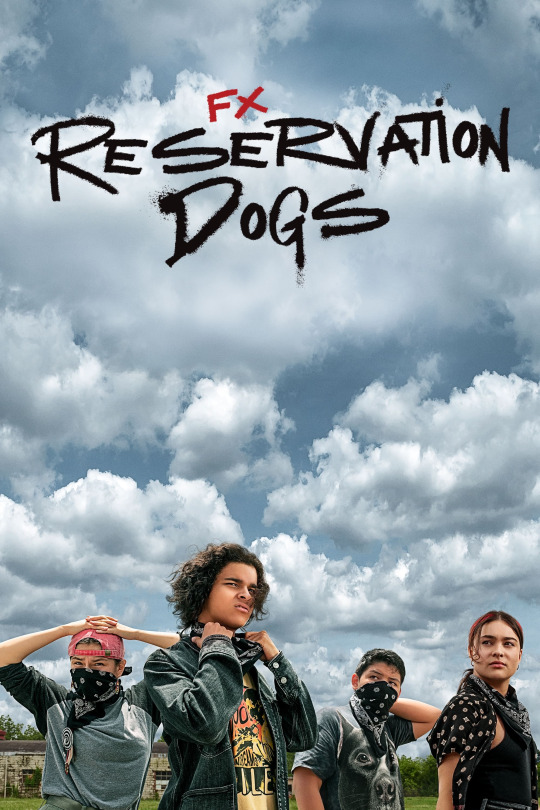
#tv series#tv shows#polls#reservation dogs#d'pharaoh woon a tai#devery jacobs#paulina alexis#2020s series#us american series#have you seen this series poll
81 notes
·
View notes
Text

Celebrate Native American Heritage Month by diving into these captivating shows and movies that honor their rich culture 📺🎬
Journey through these fascinating stories of resilience and tradition made by and about Indigenous people
#native american heritage month#movies#tv#recs#rec list#te ata#blackfeet boxing#rumble#prey#killers of the flower moon#reservation dogs#spirit rangers#rutherford falls#dark winds#fandom#fandoms
81 notes
·
View notes
Text

Photograph of Three Marine Corps Women Reservists, Camp Lejeune, North Carolina
Record Group 208: Records of the Office of War Information Series: Feature Story Photographs
Original caption: American Indian women too have joined the fighting forces against Germany and Japan. These three are members of the U.S. Marine Corps. They are [left to right] Minnie Spotted Wolf of the Blackfeet, Celia Mix, Potawatomi, and Violet Eastman, Chippewa.
Black and white photograph of three women in World War II era uniforms of the Marine Corps Reserves. They are posing for the camera by a wooden fence.
#archivesgov#1940s#world war ii#marine corps reserves#Native American women#Chippewa#potawatomi#blackfeet#October 16#1943
113 notes
·
View notes
Text

best powwow ever !!! 🥰
#iykyk#reservation dogs#fangirling#all in creators timing#powwow#i was nervous if you can’t tell#indigenous#first nations#dpharaoh#dpharaoh woonatai#ndn#guess what#it was a good day#native american#guess who#rez dogs#mine#bear smallhill#for you
114 notes
·
View notes
Text

An Israeli-American attorney is suing her supervisors at the Chicago Public Defender’s Office after being asked to remove a photo of herself holding an IDF-issued rifle against the backdrop of an Israeli flag claiming it is “akin to displaying a Nazi swastika”.
Attorney Debra Gassman, assistant public defender of Cook County, said that the photo had been taken during her volunteer service in the IDF during the first Gulf War.
Define N@zism for them! AM YISRAEL CHAI ✡️✡️✡���
naz_hashem
49 notes
·
View notes
Text
lily gladstone at the afi awards luncheon






#lily gladstone#mollie burkhart#killers of the flower moon#afi awards#american film institute#afi awards luncheon#ayo edebiri#past lives#celine song#john magaro#devery jacobs#echo#reservation dogs
28 notes
·
View notes
Photo

A breeding colony of Caribbean, or American, flamingos, in Ría Lagartos biosphere reserve, on the Yucatán Peninsula, Mexico.
Photo by Claudio Contreras Koob
Wildlife Photographer of the Year
#claudio contreras koob#photographer#wildlife photographer of the year#breeding colony#bird photography#caribbean flamingos#american flamingos#ria lagartos biosphere reserve#yucatan peninsula#mexico#animal#nature
51 notes
·
View notes
Text

#deer lady#reservation dogs#rez dogs#indigenous culture#first nations#native american heritage month#indigenous lives matter#kaniehtiio horn
78 notes
·
View notes
Text

on my mind all the time
#american psycho#i really am like that#a friend writes down future plans in a notebook = patrick bateman#someone wears raybans = patrick bateman#someone makes a reservation at a resto = patrick bateman WHO ELSE DOES THIS BUT PB AND HIS YUPPIE FRIENDS
24 notes
·
View notes
Text
The Crimson Wetlands has two separated wetland areas, one reserved for the American Flamingo and the other for Scarlet Ibis. If you looked at the photos closely, you would see there is a grey flamingo chick all by itself. I wonder where its parent is.




There are barely any big trees in this Walk In Aviary, so try to visit it during the early part of the morning when it is cooler. There is also a Cascading Waterfall where you can take shelter behind the cool misty water if our hot and humid climate is getting to you.





#Bird Paradise#Singapore#Mandai#Mandai Wildlife Reserve#Crimson Wetlands#Walk In Aviary#Wetland#American Flamingo#Scarlet Ibis#Chick#Colourful#Cascading Waterfall#Birds#Buffetlicious
24 notes
·
View notes